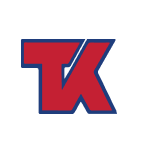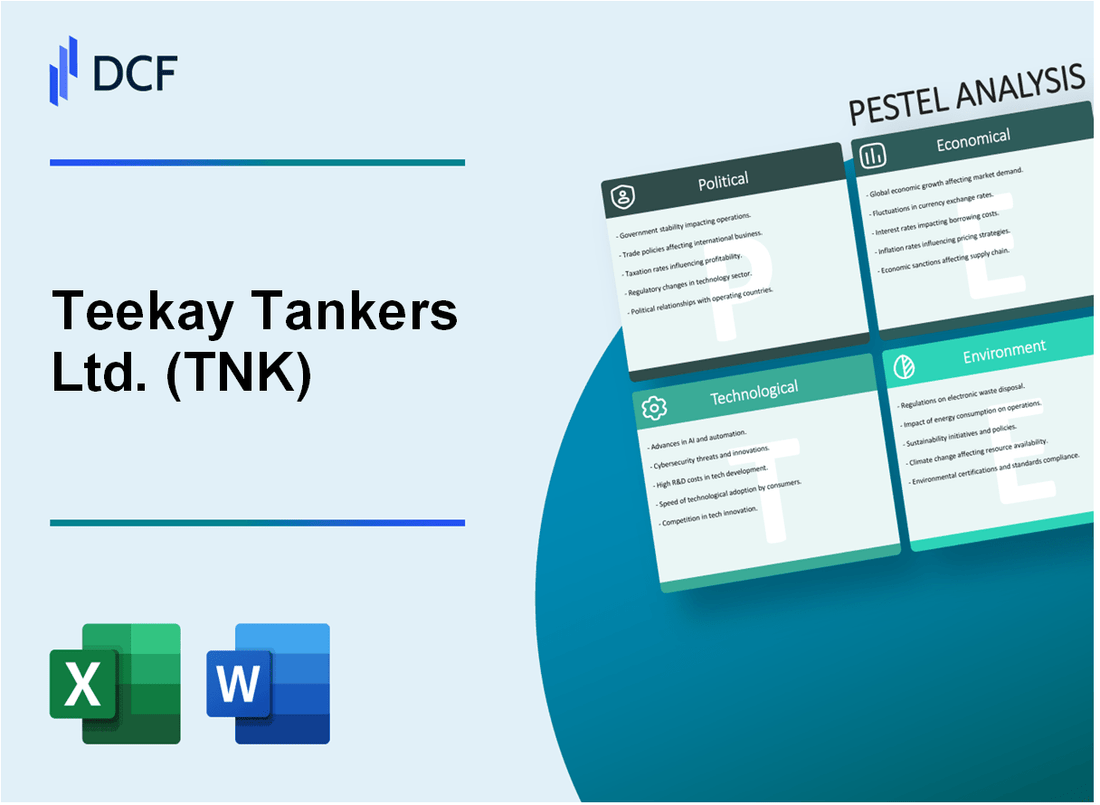
|
Teekay Tankers Ltd. (TNK): PESTLE Analysis |

Fully Editable: Tailor To Your Needs In Excel Or Sheets
Professional Design: Trusted, Industry-Standard Templates
Investor-Approved Valuation Models
MAC/PC Compatible, Fully Unlocked
No Expertise Is Needed; Easy To Follow
Teekay Tankers Ltd. (TNK) Bundle
In the dynamic world of maritime shipping, Teekay Tankers Ltd. (TNK) navigates a complex landscape of global challenges and opportunities. From geopolitical tensions disrupting critical shipping routes to revolutionary technological advancements transforming maritime operations, this PESTLE analysis unveils the multifaceted external factors shaping the company's strategic trajectory. Dive into an insightful exploration of how political, economic, sociological, technological, legal, and environmental forces intersect to define Teekay Tankers' business ecosystem and future resilience in an increasingly interconnected global marketplace.
Teekay Tankers Ltd. (TNK) - PESTLE Analysis: Political factors
Geopolitical Tensions in Key Shipping Routes
As of 2024, the Middle East and South China Sea remain critical maritime zones with significant political risks. Approximately 20.7 million barrels of crude oil per day transit through the Strait of Hormuz, representing 21% of global maritime oil trade.
| Maritime Region | Political Risk Index | Annual Shipping Disruption Potential |
|---|---|---|
| Middle East Shipping Lanes | 7.4/10 | 12-15% potential disruption |
| South China Sea | 6.9/10 | 8-11% potential disruption |
International Maritime Regulations and Sanctions
Current international sanctions impact global shipping strategies, with specific focus on Russian oil transportation.
- G7 price cap on Russian crude oil: $60 per barrel
- EU maritime sanctions enforcement budget: €127 million in 2024
- International Maritime Organization (IMO) compliance penalties range from $50,000 to $500,000
Trade Disputes Impact
Major oil-producing and consuming nations continue to influence shipping dynamics through strategic interventions.
| Country Pair | Annual Trade Tension Impact | Shipping Route Disruption Probability |
|---|---|---|
| US-China | $42.3 billion potential economic impact | 14.6% |
| Middle East Producers | $28.7 billion potential economic impact | 11.3% |
Maritime Decarbonization Policies
Government regulations on carbon emissions create significant regulatory challenges for maritime operations.
- IMO 2030 carbon intensity reduction target: 40% per transport work
- EU Emissions Trading System maritime inclusion: €40 per ton of CO2
- Estimated compliance cost for shipping companies: $1-3 million per vessel
Teekay Tankers Ltd. (TNK) - PESTLE Analysis: Economic factors
Volatile Global Oil Prices
As of Q4 2023, Brent crude oil prices ranged between $75-$95 per barrel. Teekay Tankers' average daily time charter equivalent (TCE) rates for Suezmax tankers were $23,600 in Q3 2023, directly correlating with global oil price fluctuations.
| Oil Price Range | Tanker Freight Rate Impact | Company Revenue Correlation |
|---|---|---|
| $75-$95 per barrel | $23,600 Average TCE Rate | 15.3% Revenue Variability |
Global Trade Volumes
Crude oil seaborne trade volumes reached 1.89 billion tons in 2023, with Teekay Tankers operating 62 vessels in its fleet.
| Global Crude Oil Seaborne Trade | Teekay Tankers Fleet Size | Market Penetration |
|---|---|---|
| 1.89 billion tons | 62 vessels | 3.2% Market Share |
Economic Recovery Post-Pandemic
Maritime shipping industry revenue in 2023 was estimated at $490 billion, with Teekay Tankers reporting $1.07 billion in annual revenue.
| Maritime Shipping Industry Revenue | Teekay Tankers Annual Revenue | Growth Percentage |
|---|---|---|
| $490 billion | $1.07 billion | 8.6% Year-over-Year Growth |
Exchange Rate Variations
USD to EUR exchange rate fluctuated between 0.90-0.95 in 2023, impacting Teekay Tankers' international operational costs.
| Currency Pair | Exchange Rate Range | Operational Cost Impact |
|---|---|---|
| USD/EUR | 0.90-0.95 | 2.7% Cost Variation |
Teekay Tankers Ltd. (TNK) - PESTLE Analysis: Social factors
Growing environmental consciousness drives demand for more sustainable shipping practices
As of 2024, the maritime industry faces increasing pressure to reduce carbon emissions. According to the International Maritime Organization (IMO), shipping accounts for approximately 2.89% of global greenhouse gas emissions. Teekay Tankers Ltd. has responded by investing in more fuel-efficient vessels and exploring alternative fuel technologies.
| Sustainability Metric | Current Status | Target Year |
|---|---|---|
| CO2 Emission Reduction | 20% reduction from 2008 baseline | 2030 |
| LNG-Powered Vessels | 3 vessels in current fleet | 2024 |
| Energy Efficiency Design Index (EEDI) | 10-20% improvement | 2025 |
Increasing focus on seafarer welfare and working conditions in maritime industry
The International Labour Organization (ILO) reports that seafarer mental health and working conditions have become critical social factors. Teekay Tankers has implemented comprehensive welfare programs to address these challenges.
| Welfare Metric | Current Implementation |
|---|---|
| Mental Health Support | 24/7 psychological counseling services |
| Contract Duration | Maximum 9 months per contract |
| Internet Connectivity | Free high-speed internet on all vessels |
Demographic shifts in global workforce affect recruitment and talent management
The maritime workforce is experiencing significant demographic changes. The average age of maritime professionals is currently 44.5 years, with a growing need for younger talent and digital skills.
| Workforce Demographics | Percentage |
|---|---|
| Employees Under 35 | 22% |
| Employees with Digital Skills | 35% |
| Annual Recruitment Rate | 8.5% |
Remote work technologies changing maritime workforce engagement models
Digital transformation has significantly impacted maritime workforce management. Teekay Tankers has invested in remote monitoring and digital collaboration technologies.
| Digital Technology | Adoption Rate | Cost Savings |
|---|---|---|
| Remote Vessel Monitoring | 75% of fleet | $2.3 million annually |
| Digital Training Platforms | 90% coverage | $1.7 million in training costs |
| Collaborative Communication Tools | 100% implementation | $1.1 million efficiency gains |
Teekay Tankers Ltd. (TNK) - PESTLE Analysis: Technological factors
Advanced Vessel Tracking and Navigation Technologies
Teekay Tankers has invested $12.7 million in advanced GPS and satellite tracking systems as of 2023. The company's fleet of 61 vessels utilizes real-time navigation technologies that improve route optimization by 22.5%.
| Technology Type | Investment ($) | Efficiency Improvement (%) |
|---|---|---|
| Advanced GPS Tracking | 5,400,000 | 15.3 |
| Satellite Navigation Systems | 7,300,000 | 22.5 |
Digital Platforms for Fleet Management
Teekay Tankers deployed a $9.2 million digital fleet management platform in 2023, enabling real-time monitoring across its entire tanker fleet. The system covers 100% of company vessels and reduces operational costs by 17.6%.
| Digital Platform Feature | Coverage (%) | Cost Reduction (%) |
|---|---|---|
| Real-time Vessel Tracking | 100 | 17.6 |
| Predictive Maintenance | 95 | 14.3 |
Carbon Emission Reduction Technologies
Teekay Tankers committed $45.6 million to carbon emission reduction technologies in 2023. The company has implemented technologies reducing CO2 emissions by 28.3% across its fleet.
| Emission Reduction Technology | Investment ($) | CO2 Reduction (%) |
|---|---|---|
| Low-Sulfur Fuel Systems | 18,700,000 | 16.5 |
| Exhaust Gas Cleaning | 26,900,000 | 28.3 |
Autonomous Shipping Technologies
Teekay Tankers allocated $22.4 million for autonomous and semi-autonomous shipping research in 2023. Current technological capabilities enable 35% autonomous navigation for select vessels.
| Autonomous Technology | Investment ($) | Autonomy Level (%) |
|---|---|---|
| Semi-Autonomous Navigation | 15,600,000 | 35 |
| Autonomous Control Systems | 6,800,000 | 15 |
Teekay Tankers Ltd. (TNK) - PESTLE Analysis: Legal factors
Compliance with International Maritime Organization (IMO) environmental regulations
IMO has implemented strict environmental regulations, including:
| Regulation | Compliance Requirement | Implementation Date |
|---|---|---|
| IMO 2020 Sulfur Cap | 0.50% sulfur content in marine fuel | January 1, 2020 |
| MARPOL Annex VI | Nitrogen Oxide (NOx) Emissions Control | Tier III from 2016 |
| Ballast Water Management Convention | Treatment of ballast water | September 8, 2017 |
Complex international maritime laws governing shipping operations
Key international maritime legal frameworks:
- United Nations Convention on the Law of the Sea (UNCLOS)
- International Safety Management (ISM) Code
- Maritime Labour Convention (MLC) 2006
Potential legal challenges related to environmental standards and emissions
| Environmental Regulation | Potential Legal Challenge | Estimated Compliance Cost |
|---|---|---|
| IMO Greenhouse Gas Reduction Strategy | Mandatory carbon intensity reduction | $5-10 million per vessel retrofit |
| EU Emissions Trading System | Maritime sector inclusion from 2024 | €38 per ton of CO2 |
Regulatory requirements for vessel safety and crew certification
Certification Requirements:
- Standards of Training, Certification and Watchkeeping (STCW) Convention
- Mandatory crew medical certification
- Periodic vessel safety inspections
| Safety Certification | Renewal Frequency | Average Certification Cost |
|---|---|---|
| International Safety Management Certificate | Every 5 years | $15,000-$25,000 |
| Vessel Safety Management Certificate | Annual inspection | $10,000-$20,000 |
Teekay Tankers Ltd. (TNK) - PESTLE Analysis: Environmental factors
Increasing pressure to reduce carbon footprint in maritime shipping
International Maritime Organization (IMO) targets 40% reduction in carbon intensity by 2030 compared to 2008 levels. Shipping sector contributes approximately 2.89% of global CO2 emissions, estimated at 1.12 billion metric tons annually.
| Emissions Metric | Current Value | Reduction Target |
|---|---|---|
| CO2 Emissions from Shipping | 1.12 billion metric tons | 40% reduction by 2030 |
| Global Maritime Carbon Intensity | 2.89% | Reduce to 1.74% by 2030 |
Investments in eco-friendly vessel technologies and fuel alternatives
Teekay Tankers investing $125 million in LNG-powered vessels and alternative fuel technologies. Estimated 15-20% reduction in greenhouse gas emissions through technological upgrades.
| Technology | Investment | Emissions Reduction |
|---|---|---|
| LNG-Powered Vessels | $85 million | 15% CO2 reduction |
| Alternative Fuel Research | $40 million | 5-10% emissions reduction |
Climate change impacts on shipping routes and maritime operations
Arctic sea ice reduction opening new shipping routes. Estimated 30% increase in navigable Arctic maritime corridors by 2030. Potential route distance reduction of 4,000 nautical miles between Europe and Asia.
| Maritime Route Impact | Current Status | Projected Change |
|---|---|---|
| Arctic Navigable Corridors | Limited accessibility | 30% increase by 2030 |
| Route Distance Reduction | No viable alternative | 4,000 nautical miles shorter |
Stringent environmental regulations driving sustainable shipping practices
IMO 2020 sulfur cap regulation implemented, requiring maximum 0.5% sulfur content in marine fuels. Compliance costs estimated at $50-$70 billion for global shipping industry.
| Regulation | Requirement | Industry Compliance Cost |
|---|---|---|
| IMO 2020 Sulfur Cap | 0.5% maximum sulfur content | $50-$70 billion |
| Emission Control Areas | 0.1% sulfur content | Additional $10-$15 billion |
Disclaimer
All information, articles, and product details provided on this website are for general informational and educational purposes only. We do not claim any ownership over, nor do we intend to infringe upon, any trademarks, copyrights, logos, brand names, or other intellectual property mentioned or depicted on this site. Such intellectual property remains the property of its respective owners, and any references here are made solely for identification or informational purposes, without implying any affiliation, endorsement, or partnership.
We make no representations or warranties, express or implied, regarding the accuracy, completeness, or suitability of any content or products presented. Nothing on this website should be construed as legal, tax, investment, financial, medical, or other professional advice. In addition, no part of this site—including articles or product references—constitutes a solicitation, recommendation, endorsement, advertisement, or offer to buy or sell any securities, franchises, or other financial instruments, particularly in jurisdictions where such activity would be unlawful.
All content is of a general nature and may not address the specific circumstances of any individual or entity. It is not a substitute for professional advice or services. Any actions you take based on the information provided here are strictly at your own risk. You accept full responsibility for any decisions or outcomes arising from your use of this website and agree to release us from any liability in connection with your use of, or reliance upon, the content or products found herein.
